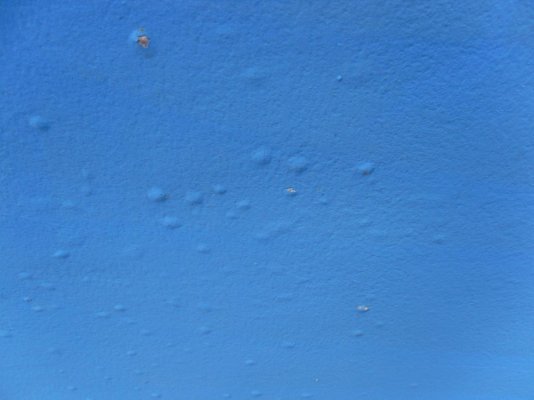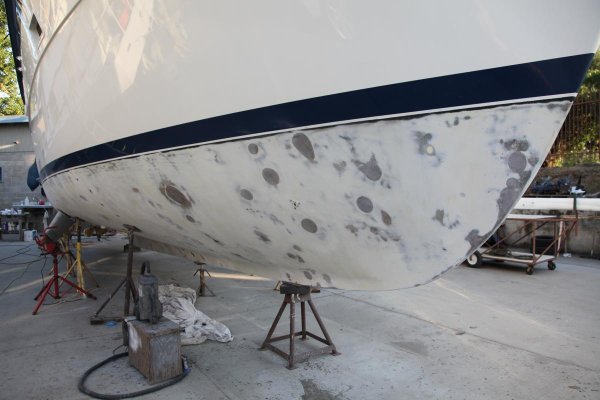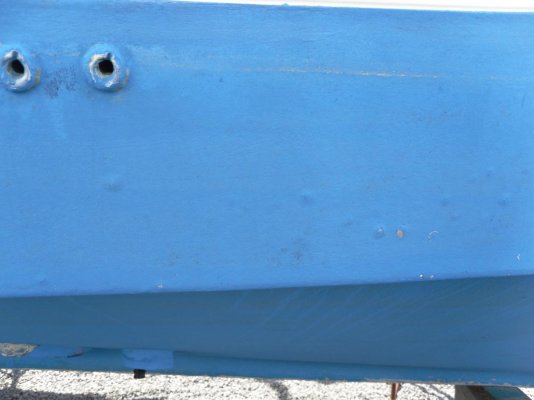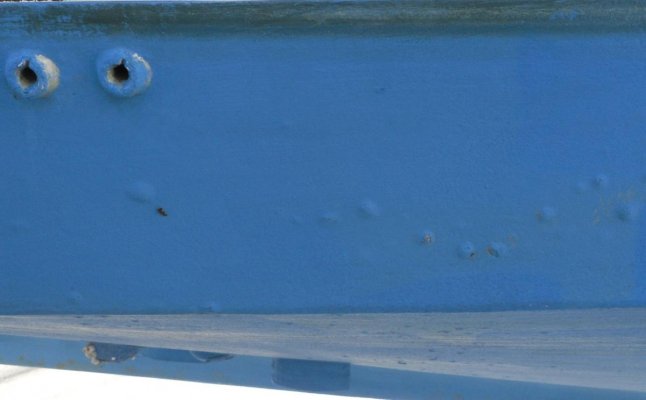Hi All, I have a 2001 trawler which was barrier coated when manufactured. The boat is kept in the water year round & up till last fall the diver said the bottom was in good condition. I am hauling this spring to clean, bottom paint, inspect gear, etc. as it has been 2 years since last haul out. I am wondering how long the barrier coat will last to prevent blistering. Thanks for any input.
You are using an out of date browser. It may not display this or other websites correctly.
You should upgrade or use an alternative browser.
You should upgrade or use an alternative browser.
How long will barrier coat last?
- Thread starter gar
- Start date
The friendliest place on the web for anyone who enjoys boating.
If you have answers, please help by responding to the unanswered posts.
If you have answers, please help by responding to the unanswered posts.
psneeld
Guru
It may not prevent blistering....there are just too many ifs.....but if done at fsctory..it should last virtually forever.
But again...understanding osmosis, blistering and hydrolysis creates a bunch of possibilities that are very hard to address.
A boat can blister from water sitting in the bilge..not necessarily from the outside.
But again...understanding osmosis, blistering and hydrolysis creates a bunch of possibilities that are very hard to address.
A boat can blister from water sitting in the bilge..not necessarily from the outside.
Moonstruck
Guru
- Joined
- Nov 27, 2008
- Messages
- 8,276
- Location
- USA
- Vessel Name
- Moonstruck
- Vessel Make
- Sabre 42 Hardtop Express
I have never heard of an epoxy barrier coat wearing away.
Scary
Guru
I was told to expect ten years
I just redid mine for the second time. The previous owner had done it approximately 10 years before I bought my boat. So 14 years or so later when I hauled this summer I had quite a few blisters. I had the bottom sandblasted and repaired several hundred blisters and applied Procoat epoxy barrier and then Procoat epoxy bottom paint. My boat rests in fresh water and has for 30 plus years. Cruises in salt water moores in fresh. I have been told that blistering occurs more often in fresh water, I have no scientific prove.
I just redid mine for the second time. The previous owner had done it approximately 10 years before I bought my boat. So 14 years or so later when I hauled this summer I had quite a few blisters. I had the bottom sandblasted and repaired several hundred blisters and applied Procoat epoxy barrier and then Procoat epoxy bottom paint. My boat rests in fresh water and has for 30 plus years. Cruises in salt water moores in fresh. I have been told that blistering occurs more often in fresh water, I have no scientific prove.
I read somewhere Interprotect was good for 10 to 12 years. That seems to be pretty accurate based on the many hulls I have inspected. At some point it seems to start becoming disbonded and needs patching. If a lot of that is occurring a do over is in order. As long as it is staying put I would leave it alone.
fryedaze
Guru
- Joined
- Sep 4, 2011
- Messages
- 1,753
- Location
- USA
- Vessel Name
- Fryedaze
- Vessel Make
- MC 42 (Overseas Co) Monk 42
Here is my real life data. My boat was barrier coated in June 2003 with 1 coat epiglass and 6 coats interprotect. From 2003 to 2005 it was hauled and out of the water for 5 months each year. In 2006 it was in the water for a year doing the loop. 2007 to May 2010 it was pulled for 5 months a year. 2010 to present it was in the water year round and hauled for a week every two years. From 2010 to May 2014 no signs of blisters until May 2014. During the May haulout small 1/4" blisters the size of a pencil eraser showed up.
Attachments
psneeld
Guru
As I posted in post #2 .....
Every boat and every situation is different. Even every application could be slightly different.
The general consensus is some epoxies and vinylesters slow water intrusion (from one direction) but beyond that....there are so many variables it is mind boggling.
Much like paint...preparation is huge and mostly not done well....then come care and use where everyone's mileage may vary.
Every boat and every situation is different. Even every application could be slightly different.
The general consensus is some epoxies and vinylesters slow water intrusion (from one direction) but beyond that....there are so many variables it is mind boggling.
Much like paint...preparation is huge and mostly not done well....then come care and use where everyone's mileage may vary.
O C Diver
Guru
- Joined
- Dec 16, 2010
- Messages
- 13,333
- Location
- Fort Myers, Florida
- Vessel Name
- End Of The Line
- Vessel Make
- Trinka 10 Dinghy
My boat was 13 years old when we hauled. There were a few spots where the bottom paint was peeling from the hull and a spot on the hull forward of the rudder that dripped water for days after it was blocked. Decided to sand blast all the bottom paint off to know the real condition of the hull. Very happy that I did this. The boat is a 2 part hull. It was laid up in 2 molds and then the 2 pieces were glassed together. While the hull is very strong and water tight, there were spots where the hull pieces were glassed together, that poor glass work and bondo on the outside left air pockets where water collected in the hull. By blasting the hull we were able to find these pockets, grind them out and properly reglass them. Plan to own the boat for 10 to 15 years and considered this a good preventive investment.
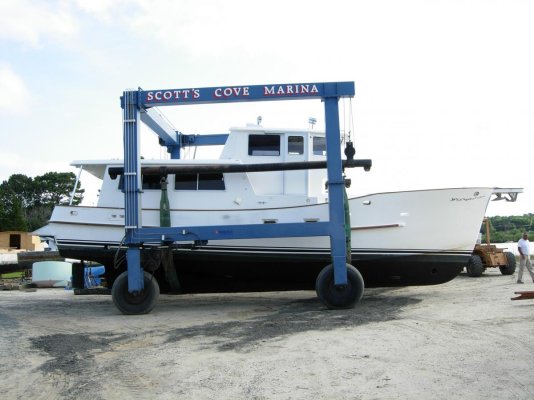
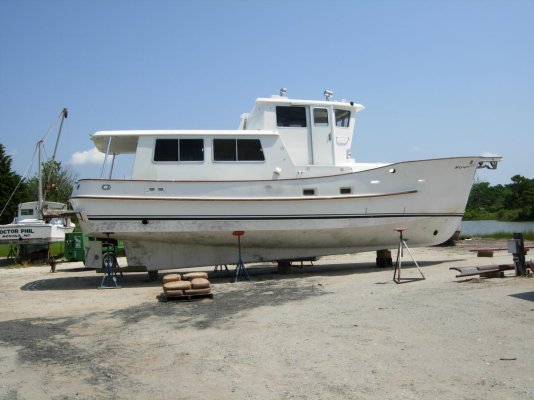
Red fairing compound covers an area on the transom that had to be ground out and reglassed.

Ted


Red fairing compound covers an area on the transom that had to be ground out and reglassed.

Ted
Scary
Guru
you have to get to the bottom of it.
Sand blasting was a good idea. I'm glad I did as well. I spent a lot of time fairing after sandblasting.My boat was 13 years old when we hauled. There were a few spots where the bottom paint was peeling from the hull and a spot on the hull forward of the rudder that dripped water for days after it was blocked. Decided to sand blast all the bottom paint off to know the real condition of the hull. Very happy that I did this. The boat is a 2 part hull. It was laid up in 2 molds and then the 2 pieces were glassed together. While the hull is very strong and water tight, there were spots where the hull pieces were glassed together, that poor glass work and bondo on the outside left air pockets where water collected in the hull. By blasting the hull we were able to find these pockets, grind them out and properly reglass them. Plan to own the boat for 10 to 15 years and considered this a good preventive investment.
View attachment 37073
View attachment 37074
Red fairing compound covers an area on the transom that had to be ground out and reglassed.
View attachment 37075
Ted
Attachments
Old deckhand
Guru
The warmer the water the greater the blistering. Many boats in our cool waters never blister. I assume the length of time the barrier coat last is also proportional to the water temperature.
psneeld
Guru
not sure the barrier coat goes away unless destroyed intentionally or unintentionally...
but water does permeate even epoxy.....some more so than others...thus most barrier coats have stuff in them to slow it.
and correct about water temps...another few years in the Florida canal my boat called home and the bottom may have been much worse than the nightmare it was with hydrolysis.
but water does permeate even epoxy.....some more so than others...thus most barrier coats have stuff in them to slow it.
and correct about water temps...another few years in the Florida canal my boat called home and the bottom may have been much worse than the nightmare it was with hydrolysis.
barrier coats are just a layer of epoxy paint (10 -20 mils thick) designed to waterproof a porous fiberglass hull system. It will not 'wear out' etc. but like any coating system, it can fail due to poor adhesion, flexing etc. Blasting etc can contaminate the surface for a less then perfect bond (did you use an epoxy primer?). Baby blisters can continue to grow and become visible. Water can come from the inside etc. Many factors at play
paul oman
progressive epoxy polyers inc (epoxyproducts.com)
paul oman
progressive epoxy polyers inc (epoxyproducts.com)
fryedaze
Guru
- Joined
- Sep 4, 2011
- Messages
- 1,753
- Location
- USA
- Vessel Name
- Fryedaze
- Vessel Make
- MC 42 (Overseas Co) Monk 42
I had the boat pulled Monday for some prop work. I took follow up pictures so I can track my blister issue. Post #6 was nine months ago. I will post Mondays pictures late this week when I get back to the cameras. I can see they are growing. The quantity does not appear to have changes but the size has.
Scary
Guru
In my case I used Provost epoxy primer and barrier coat applied per instructions while the primer was still tacky. I tested my hull with a moisture meter before application of the primer. I don't rember the reading but was very dry, we were surprised at the time as we only been out of the water about a month. We had very hot dry weather and I think the sand blasting opened up the resin speeding up the drying.
windmill29130
Guru
- Joined
- Jan 22, 2011
- Messages
- 716
- Vessel Name
- JAZ
- Vessel Make
- Ta Chaio/CT35
If you apply barrier coat on a hull that is wet it is going to blister. You must make sure the hull is dry first, then the barrier coat should last a very very long time. Keeping the bilge dry is important as well. It can enter from the inside just as easily as it can from the outside.
air can escape from a blasted unsealed hull under an epoxy barrier coat (which is generally 100% surface bond). Apply coatings to hulls when temp is falling so any air in the fiberglass skin will be cooling and contracting. If applied when temps rise the air has to go someplace as it expands. could be trapped under the epoxy barrier coat. High end epoxy sealers like ESP 155 are good under a barrier coat, especially if the fiberglass is old or weathered, or 'damaged' by blasting to remove old coatings
fryedaze
Guru
- Joined
- Sep 4, 2011
- Messages
- 1,753
- Location
- USA
- Vessel Name
- Fryedaze
- Vessel Make
- MC 42 (Overseas Co) Monk 42
Finally got back to the camera. The first picture is May 2014 and the next one is Feb 2015. I will continue to monitor.I had the boat pulled Monday for some prop work. I took follow up pictures so I can track my blister issue. Post #6 was nine months ago. I will post Mondays pictures late this week when I get back to the cameras. I can see they are growing. The quantity does not appear to have changes but the size has.
Attachments
River Cruiser
Guru
- Joined
- Jan 25, 2013
- Messages
- 1,357
- Location
- US
- Vessel Name
- Northern Lights II
- Vessel Make
- Bayliner 3870
This is a very timely topic for me because Northern Lights is spending the winter and part of the spring in the marina's shop having several projects done. The bottom was blasted last fall the other projects have been getting done since then. Once it warms up enough in the spring they will start on the bottom, it is getting 5 coats of Interlux Interprotect 2000 barrier coat and then new anti-fouling paint. I confess that I have no idea how long the barrier coat should last, after the launch this spring it'll be hauled every 2 years for anodes and to clean and check the hull, running gear and paint.
Similar threads
- Replies
- 0
- Views
- 2K

